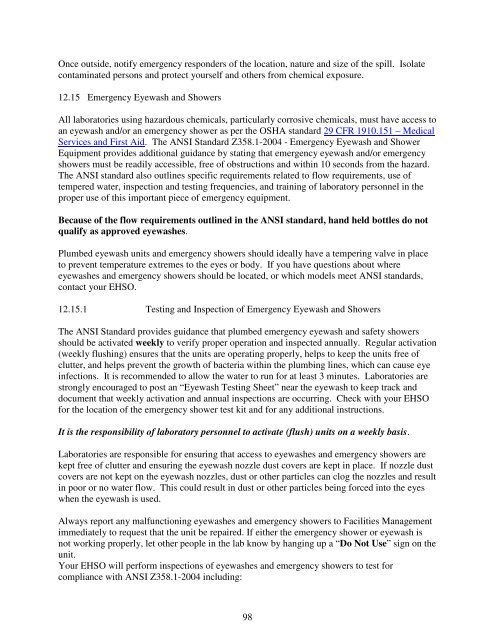Chemical Hygiene Plan - Queensborough Community College ...
Chemical Hygiene Plan - Queensborough Community College ...
Chemical Hygiene Plan - Queensborough Community College ...
You also want an ePaper? Increase the reach of your titles
YUMPU automatically turns print PDFs into web optimized ePapers that Google loves.
Once outside, notify emergency responders of the location, nature and size of the spill. Isolate<br />
contaminated persons and protect yourself and others from chemical exposure.<br />
12.15 Emergency Eyewash and Showers<br />
All laboratories using hazardous chemicals, particularly corrosive chemicals, must have access to<br />
an eyewash and/or an emergency shower as per the OSHA standard 29 CFR 1910.151 – Medical<br />
Services and First Aid. The ANSI Standard Z358.1-2004 - Emergency Eyewash and Shower<br />
Equipment provides additional guidance by stating that emergency eyewash and/or emergency<br />
showers must be readily accessible, free of obstructions and within 10 seconds from the hazard.<br />
The ANSI standard also outlines specific requirements related to flow requirements, use of<br />
tempered water, inspection and testing frequencies, and training of laboratory personnel in the<br />
proper use of this important piece of emergency equipment.<br />
Because of the flow requirements outlined in the ANSI standard, hand held bottles do not<br />
qualify as approved eyewashes.<br />
Plumbed eyewash units and emergency showers should ideally have a tempering valve in place<br />
to prevent temperature extremes to the eyes or body. If you have questions about where<br />
eyewashes and emergency showers should be located, or which models meet ANSI standards,<br />
contact your EHSO.<br />
12.15.1 Testing and Inspection of Emergency Eyewash and Showers<br />
The ANSI Standard provides guidance that plumbed emergency eyewash and safety showers<br />
should be activated weekly to verify proper operation and inspected annually. Regular activation<br />
(weekly flushing) ensures that the units are operating properly, helps to keep the units free of<br />
clutter, and helps prevent the growth of bacteria within the plumbing lines, which can cause eye<br />
infections. It is recommended to allow the water to run for at least 3 minutes. Laboratories are<br />
strongly encouraged to post an “Eyewash Testing Sheet” near the eyewash to keep track and<br />
document that weekly activation and annual inspections are occurring. Check with your EHSO<br />
for the location of the emergency shower test kit and for any additional instructions.<br />
It is the responsibility of laboratory personnel to activate (flush) units on a weekly basis.<br />
Laboratories are responsible for ensuring that access to eyewashes and emergency showers are<br />
kept free of clutter and ensuring the eyewash nozzle dust covers are kept in place. If nozzle dust<br />
covers are not kept on the eyewash nozzles, dust or other particles can clog the nozzles and result<br />
in poor or no water flow. This could result in dust or other particles being forced into the eyes<br />
when the eyewash is used.<br />
Always report any malfunctioning eyewashes and emergency showers to Facilities Management<br />
immediately to request that the unit be repaired. If either the emergency shower or eyewash is<br />
not working properly, let other people in the lab know by hanging up a “Do Not Use” sign on the<br />
unit.<br />
Your EHSO will perform inspections of eyewashes and emergency showers to test for<br />
compliance with ANSI Z358.1-2004 including:<br />
98

















